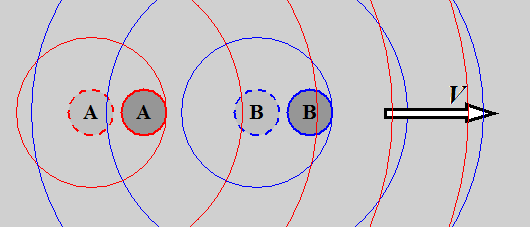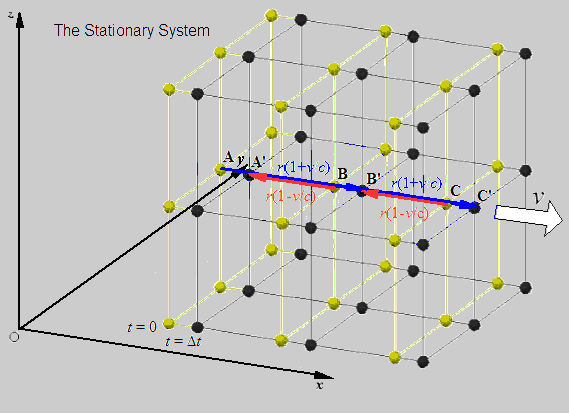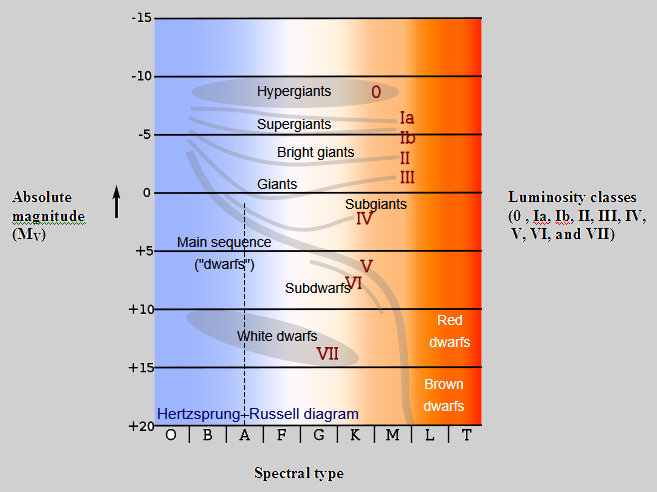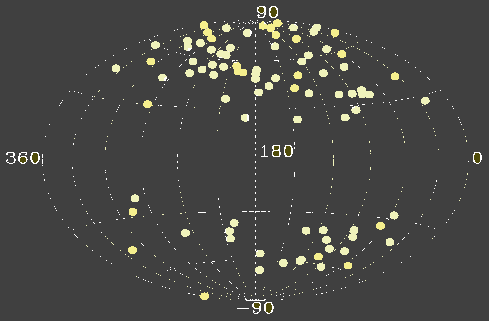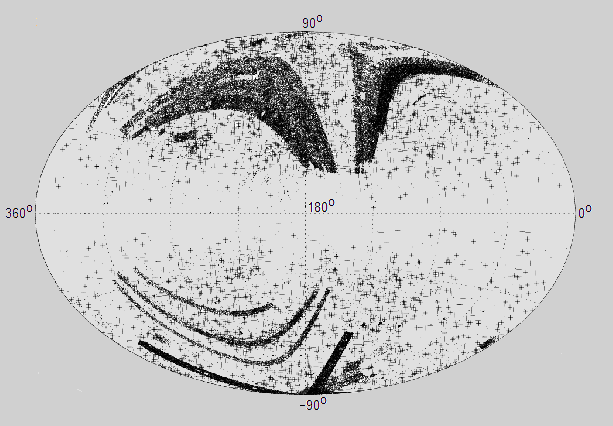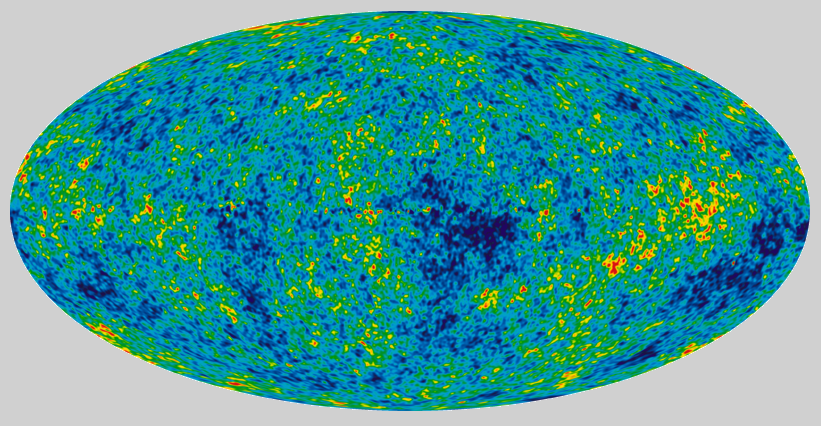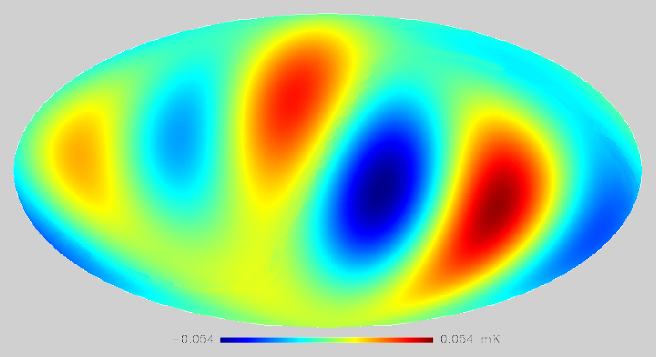| Comments: post@finaltheories.com | |
|
|
If you want to promote the theory about "The structure and composition of the cosmos", so please tell others about it. |
|
Deduction of the Theory | Mass and Energy | Evaluation of the Theory | Test of the Theory |
| Proof: Special Relativity is Wrong |
|
Evaluation of the Quantum Ether Theory All the relativistic relations derived in connection with the Quantum Ether Theory are based on the existence of the zero-point field, which is a combination of the lowest energy states of all fields. This is in line with Hendrik Antoon Lorentz's derivation of the Lorentz contraction from the existence of an ether, [1] where the relativistic relations likewise arose from a motion relative to the propagation velocity of the electromagnetic field. |
Evaluation
of the Quantum Ether Theory |
|
|
|
Relativity in the Quantum Ether Theory
The theory not only looks at the electromagnetic field, but incorporates all fields that propagate at the speed of light, which is especially true for the gravity field, which can be seen from, that gravity is of electromagnetic nature. From
Maxwell's equation of the propagation of light, we know that: [2]
μ0ε0= 1/c2, where μ0 is the magnetic constant and ε0 is the electric constant of the zero-
point field,
and c
is the speed
of light in
the zero-point
field,
and from the quantum theory we know that: [3]
E = hf , where E is the energy, h is the quantum of action, also called Planck's Constant, and f is the frequency of a wave-particle,
and finally we have, according to the mass energy equivalence, that: [4]
E
= mc2,
where m is the mass and c
is the speed of light in vacuum.
From these equations we
find, that the mass, m, is equal to:
m = E/c2 = μ0ε0hf.
It is seen that the mass of a particle is a result of the underlying electromagnetic field, since μ0 is the magnetic constant and ε0 is the electric constant of the zero-point field, and since μ0, ε0, and h all are constants, the mass and the inertia of a wave-particle only depends on its frequency, that is: the higher the frequency, the heavier the particle, and the greater its inertia.
Since
the
gravitational
force
according to
Newton's law
of universal
gravitation
equals:
[5]
F
= Gm1m2/r2,
where G
is the
gravitational
constant and r
is the
distance
between the
center of mass of the particles,
we find that:
F = G(μ0ε0h)2f1f2/r2.
From
the expression
it can be seen
that the
gravitational
force only
depends on the
frequency of
the particles
and their
mutual
spacing.
Furthermore,
since both
the magnetic constant, μ0,
and the electric
constant, ε0, is
included in the term, there is much
to suggest that the gravitational
force is of electromagnetic nature,
why it, just as the electromagnetic
radiation, propagate with the speed
of light, c, in the
zero-point field, which is in
agreement with the Quantum Field
Theory.
|
Relativity in the Quantum Ether Theory |
|
|
|
|
The Space is Euclidean
In connection with the derivation of the Euclidean Cosmos Theory, it is crucial that the space is Euclidean. When we consider the expressions for the length contraction x' = x(1 - v2/c2)½ and the "time dilation" t' = t(1 - v2/c2)½ - which occur both in Lorentz theory of "Electromagnetic phenomena in a system moving with any velocity smaller than that of light.", [1] and in Einstein's relativity, [6]
-
it is seen, that the time is shrinking
with exactly the same factor as the
length, so the time pass just as fast in a
moving system as in a stationary system.
So the time is absolute and universal even
according to Hendrik Antoon Lorentz and
Albert Einstein.
When
we look at space and time as a combined
space-time, the time axis is then just as
linear as the three coordinate axes, and
since the curvature of space-time only
depends on the time axis, the space does
not curve. It means that the space is
Euclidean, so the gravitational field
cannot be explained by the curvature of
space-time.
The gravitational field must therefore be generated by gravitons, just like the electromagnetic field is generated by virtual photons, where the virtual photons and the gravitons propagate in the zero-point field with the constant velocity c. This leads to the relativistic gravitational force, where
FG' = Gm1m2/[r2(1
- v2/c2)]
has the same structure as the relativistic equation for the electromagnetic force. This relativistic gravitational force can for example be verified by its ability to explain the apsidal precession of the planet Mercury [7] and other relativistic phenomena that involve the gravitational force. |
The Space is
Euclidean
|
|
|
|
|
Relativity has a Physical
Explanation Let us consider two particles A and B, which moves to the right with the common velocity v relative to the zero-point field and thereby relative to the propagation velocity, c, of the gravitational force. Let A be to the left of B. Since the force decreases with the square of the distance, and since B moves away from A, during the time it takes the force to get from A to B, the force on B will decrease; and since A approaches B, during the time it takes the force to get from B to A, the force on A will increase. Because the shortest distance (from B to A) provides the biggest forces, the body will shrink. This is due to the physical conditions, and since the physical dimensions of a moving clock is subjected to a similar length-contraction, the clock-time will, depending on the physical construction of the clock, be altered.
Fig. Two particles A and B, which moves to the right with the commen velocity v.
However, since it is the clock-time that is altered, and not the flow of time t, and since the velocity of the photons propagate with the constant velocity c = (ε0μ0)-½, where ε0 is the vacuum permittivity and μ0 is the vacuum permeability of the zero-point field, the product c·t is a linear function of time. So, when we choose to look at space and time as a combined space-time, the time axis is just as linear as the three coordinate axes, why the space is Euclidean.
From the constant propagation velocity of the forces (such as virtual photons and gravitons) relative to the zero-point field, it is possible to calculate the relativistic forces on bodies that move relative to the field and thereby relative to the forces that bind the bodies together. The theory explains in this way all the relativistic relations such as the length contraction, the "time dilation", the relativistic mass, the mass-energy equivalence, the black holes, the influence of the gravitational field on the clock-time, and the deflection of mass and energy in a gravitational field, where the mass m of a wave-particles, such as light, is equal to m = "ε0μ0E = "ε0μ0hf. The Quantum Ether Theory gives in this way a physical explanation of relativity. |
Relativity has a Physical Explanation |
|
|
|
|
Inertial Systems and
Relativity
In relation to
relativistic questions, inertial systems should
be depicted symmetrically, as they otherwise
will give a distorted picture of reality.
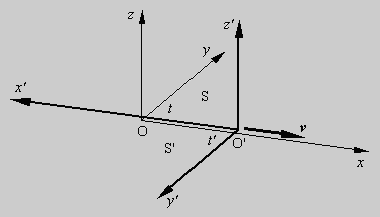
Figure: The length
contraction of the coordinate axes.
Seen
from the stationary system S, the x'-coordinate
will, because of the motion of the x'-axis
relative to the propagation velocity of the
electromagnetic forces that hold the axis together, be
equal to x(1 - v2/c2)½, measured in the system S. This means that seen from S, the length of the x'-axis will be exposed to a length contraction, because of its velocity v relative to the Zero Point Field (ZPF), so the length of the coordinate axis from 0 to x' measured in the coordinate system S becomes:
lx'l = lxl(1 - v2/c2)½.
Seen from the moving
system S', the x-coordinate will,
because the x-axis is at rest relative
to the Zero Point Field, be equal to x'/(1 - v2/c2),
measured in the system S'. This is because of
the length contraction of the x'-axis,
owing to its velocity v relative to
the propagation velocity of the electromagnetic
forces that hold the coordinate axis together.
This means that seen from S', the x-axis
will be exposed to a length dilation, because it
is at rest relative to the Zero Point Field
(ZPF), so the length of the x-axis
from 0 to x measured in the coordinate
system S' becomes:
Figure: The
electromagnetic forces in a body with the
velocity v in the x-direction.
it is easy to imagine,
that all the oblique forces (not shown in the
figure) between the different atoms, will be
exposed to changes, depending on their angle in
relation to the direction of motion. So a solid
body that moves in the x-direction
will also be exposed to length contractions in
the y- and z-direction. This
correlation between the extent of a body and its
velocity relative to the zero-point field was
also found by H. A. Lorentz. [1]
That is: relativity
arises as a consequence of the final constant
velocity of the forces relative to the
zero-point field, such that when a body moves
relative to the zero-point field, it also moves
relative to the propagation velocity of the
forces, whatever it is the gravitational or
electromagnetic field. Relativity is accordingly
a physical quality. |
Inertial Systems and Relativity
|
|
|
|
|
Evaluation of the
Euclidean Cosmos Theory
The evaluation compares the
results of the theory with many of the
observations and measurements already available of
our Universe. It is done, because a theory among
other things should be judged on how well it
describes the physical reality that surrounds us.
By comparing the Euclidean Cosmos Theory with the recent observations of our Universe, there has not been any observations - such as, the early star formation, the network structure, the apparent expansion, the dark matter, the dark energy, etc. - that the Euclidean Cosmos Theory has not been able to give a rational logical explanation of.
The observational values that I hold the theory up against rely, among others, on the Concordance Cosmology Model. These observational values are quite excellent to verify, whether the proposed theory is tenable. This is because the Lambda CDM or Concordance Model evidently is in concordance with the latest observations of our Universe.
Many of the physical phenomena relating to cosmology are of such a magnitude that it can be difficult to develop a test, which is able to confirm or refute a theory about the Cosmos. In such cases, it may be more useful to regard the physical realities that the theory describes. Moreover, our Universe itself performs the most spectacular tests, whose results it is hard to get around, although laboratory experiments are pointing in another direction. Therefore, we will here stick to the physical observations in connection with the evaluation of the theory.
|
Evaluation of the Euclidean
Cosmos Theory
|
|
|
|
|
The Observations support the Euclidean Cosmos Theory
All the
observations that have been performed in connection
with our Universe support the Euclidean Cosmos Theory.
This applies, for example, to the distribution of
energy in a galaxy, where the theory leads to, that
the energy due to gravity collects around the center
of a galaxy, where the nebulae and stars are lying
among the black holes and barren objects that make up
the skeleton of the galaxy; or the generation and
distribution of energy in the Universe, which can be
explained by known physical laws, where the
regenerative processes create the energy for the new
stellar nebulae; or the plasma red-shift that do not
need a big bang to explain the observed red-shift; or
the Great Walls that are created during hundred of
billions of years; or the existence of stars,
galaxies, and quasars as far as we can see; or the
existence of metals even at the highest red-shift; and
so on.... Besides, I will just add, that by comparing he Euclidean Cosmos Theory with the recent observations of our Universe, there has not been any observations - such as, the early star formation, the network structure, the apparent expansion, the dark matter, the dark energy, etc. - that the thesis has not been able to give a rational logical explanation of. |
The Observations support the
Euclidean Cosmos Theory |
|
|
|
|
Free Particles can Escape from a Black Hole
The source of the most essential
regenerative processes are the Active Galactic
Nuclei (AGN) at the center of the galaxies. Since
the black holes with their neutron stars, which
generate the Active Galactic Nuclei, are a result of
a mass concentration in the Euclidean space, the
particles will be able to leave the black holes, if
they are able to achieve a velocity that is greater
than the speed of light.
m = m0/(1-v2/c2)½.
However, free particles like the
quarks and guons in a quark-gluon plasma, which are
not bound together by forces that propagates with
the velocity of light, c, will be able to
achieve velocities greater than the speed of light.
Such free particles will be able to reach a velocity
equal to 2½c before their mass
approaches infinity. This can be seen from the found
expression of the relativistic mass, m', of
a wave-particle with the velocity v relative
to the zero-point field, which are located in a
gravitational field at the distance r from
the center of mass with mass M:
Since the relativistic mass m'
of a single wave-particle with a velocity v
is less than or equal to m' = m0/(1 - v2/2c2), the hot, dense quark-gluon plasma will not have any problems leaving the black hole.
|
Free Particles can Escape from a Black Hole |
|
|
|
|
The Farthest Objects are
Observed as Galaxies, and Quasars
Since even the most luminous objects,
such as galaxies and quasars, which are more than
13.39 billion light years away, for the moment are too
far away to be observed, it will first be possible to
study such objects, when we get more powerful
telescopes. Additionally, if we one day will be able
to observe the circumference of our Universe, we may
observe an asymmetric distribution of visible matter,
reflecting our position relative to the center of our
Universe.
|
The Farthest Objects are Observed as Galaxies, and Quasars |
|
|
|
|
The
Oldest Star is older than the Big Bang
One
single star at an age greater than the time since
the Big Bang, is enough to overthrow the Big Bang
theory, and support thus indirectly the Euclidean
Cosmos Theory. Researchers at the Space Telescope
Science Institute in Baltimore have found a star
with an age of 14.5 billion years, plus-minus 0.8
billion years, [8]
which,
with a certain probability, makes it older than the
calculated age of the Universe of 13.80 ± 0.04
billion years.
From
the true distance of the star, an exact value for
the star's intrinsic brightness can be calculated,
by the help of which the age of the star can be
estimated by applying theories about the star's burn
rate, chemical abundances, and internal structure.
Figure: Hertzprung-Russell
diagram. The result is that the star's age is estimated to 14.5 ± 0.8 billion years, with an uncertainty, which makes it comparable with the age of our Universe at 13.799 ± 0.021 billion years. So when the time for the creation of the environment is included, which is a condition for the generation of a star with such a metallicity, [8] we do have a problem. The metal content of HD 140283 is equal to [Fe/H] = -2.40 ± 0.10. This is at least ten thousand times more than the first primordial gas clouds contain, which are estimated to have a metallicity of less than -6.0. The question is, where does this metal come from, and how long does it take to produce such a quantity of metals. Despite HD 140283 is the oldest known star for which a reliable age has been determined, it is, given its low but non-zero metallicity, not quite a primordial star. It has been proposed that there might exist so-called Population III stars, which could contribute to the metal content, but since HD140283 already is of the same age as the Universe, there has not been the time for such a Population III to arise and spread its metals through supernova explosions. If we to the age of the star add the time it takes to create the surroundings that is a prerequisite for the found metallicity plus the birth and development the star, we have a universe with an age that by far exceeds the time since the Big Bang. There is therefore only one explanation to the existence of such a star, it must have been present at the time of the Big Bang. The existence of the star HD 140283 supports i this way the Euclidean Cosmos Theory. |
The Oldest Star is older than the Big Bang
|
|
|
|
|
Quasars are Observed
between 750 million and 13.36 billion ly away
As our Universe according
to the Euclidean Cosmos Theory has existed for a
very, very long time, the activity of the stars,
galaxies, and quasars must be reasonably
constant, when we look back in time. Quasars or
quasi-stellar radio sources are because of their
luminosity the most energetic and distant
members of the class of objects called Active
Galactic Nuclei (AGN), so they are among the
best sources, when we shall look back in time.
Figure: An
all-sky image of the distribution of some of the
brightest 86 quasars.
The masses of the large
central black holes in quasars have been
measured to 106 -109 solar
masses. Several dozen of our nearby large
galaxies, which show no signs of activity, have
been shown to contain similar central black
holes in their nuclei, so it is thought that all
large galaxies have a black hole at the center,
but only a small fraction are active and
therefore seen as quasars. The quasars show us
the locations where massive black holes grow in
step with the mass of stars in their host
galaxy.
|
Quasars are Observed between
750 million and 13.36 billion ly away
|
|
|
|
|
The Old Quasars contain Metals and Carbon
The
most common gases in the Universe are hydrogen and helium, so
within astronomy, metallicity, which is designated Z, is the
fraction of matter that is made up of chemical elements other
than hydrogen and helium.
|
The Old Quasars contain Metals and Carbon |
|
|
|
|
The Dark Matter Halos consist of Baryonic Matter
A galactic halo is a
collection of "dark matter" that
encloses the galactic disk and
stretches far beyond the edge of the
visible galaxy. The halo's mass
dominates the total mass of the
galaxy, and since halos consist of
dark matter, they cannot be observed
directly. But their existence can be
derived from their effects on the
movements of stars and gas in the
galaxies.
However, most of the gas
will stay relatively near the center
of the galaxy, where the gas clouds
will deliver the energy for the next
generations of stars, [36]
while
the remaining gas, because of the
gigantic gravitational field of the
central black hole, will flow towards
the center, where the gas along with
the galaxy's old material will fall
onto the accretion disc around the
black hole. [37]
The
accretion rate onto the central black
holes is observed to be directly
proportional to the luminosity
produced by the Active Galactic
Nuclei, and the distribution of the
most luminous Active Galactic Nuclei
has its peak in the red-shift range of
2 - 3, corresponding to a Hubble
distance of 11 Gly - 12 Gly. [38]
The black hole nucleus of
the galaxy shines as an optical quasar
until the reservoir mass is exhausted
on a timescale of 107 yr.
Since then, the host galaxy evolves
passively and the black hole becomes
dormant, apart from a possible
reactivation. [39]
The
outflows from such quasars may reach
velocities ranging from 0.1c to
0.4c, where c is the
velocity of light. This is based on
observations of X-ray broad absorption
lines performed with the Chandra and
XMM-Newton X-ray observatories. [40]
Regarding the visible
disk of the Milky Way Galaxy, it is
embedded in a much larger roughly
spherical halo of dark matter, whose
density drops off with the distance
from the galactic center. It is
believed that about 95% of the Galaxy
is composed of dark matter, which only
interact with the rest of the galaxy
through gravity. The luminous matter
of our galaxy consists of
approximately 9 x 1010
solar masses, while the dark matter is
likely to include between 6 x 1011
to 3 x 1012 solar masses. [48]
Imagine an infinitely
old, closed Universe, where almost all
the stars are burned out and
transformed into invisible black
holes. This is quite likely, as it
only requires about 3.2 solar masses
to create a black hole with a size of
9.4 km. Due to gravity, all the black
holes will either collide or swirl
around each other as giant invisible
galaxies of all different kinds, which
again have created all possible sorts
of concentrations of galaxies, such as
Great Walls, Giant Rings, Giant
Strings and Super Clusters, which all
are bound together by galaxy
filaments. These threadlike galaxy
filament formations can have a length
of 160 to 260 million light-years, and
form the boundaries between the large
voids in the Universe.
|
The Dark Matter Halos consist of Baryonic Matter
|
|
|
|
|
The
many
Regenerative
Explosions are
mirrored in
the CMB
The
cosmic microwave background provides some
of the best knowledge we have about the
structure, content, and history of the
Universe. Through many years hundreds of
experiments have been conducted to measure
and characterize the signatures of the
Cosmic Microwave Background radiation. The
NASA Cosmic Background Explorer (COBE)
satellite has detected and quantified the
large-scale anisotropies, and a series of
experiments have later quantified CMB
anisotropies on smaller angular scales.
From the CMB it can be seen that at very large scales there arise fluctuations in the power spectrum. The temperature variations are both larger than expected and aligned with each other to a very high degree. This is at odds with the standard cosmological model where the CMB anisotropies should be randomly oriented, not aligned. In fact, since the smaller-scale variations are random, it makes the deviation at larger scales much more strange. These large-scale deviations are reflected in temperature fluctuations much larger than any galaxy cluster. According to the Euclidean Cosmos Theory these large-scale deviations may reflect the position of the visible universe in relation to the center of our closed Universe.
|
The many Regenerative Explosions are mirrored in the CMB |
|
|
|
|
References 1.
Hendrik
Antoon Lorentz. "Electromagnetic phenomena
in a system moving with any velocity smaller than that of light." Proceedings of the Royal Netherlands Academy of Arts and Sciences, 6: 809-831, 1904.
London, Edinburgh and Dublin, 1861.
3.
M. Planck. "On the Law of the Energy Distribution
in the Normal Spectrum." Deutsche
Physikalische Gesellschaft, Berlin, 1900. 4. www.finaltheories.com: "Mass and Energy", section two: Mass and Energy are Equivalent Quantities: E = mc2.
5. Isaac Newton. "Philosophiæ Naturalis Principia Mathematica." (the Principia), first published July
1686.
6.
Albert Einstein et al. "The Principle of
Relativity." Dover Publications, New York, 1952. 7. Richard Fitzpatrick. "Perihelion Precession of Mercury." Institute for Fusion Studies, The University
of Texas at Austin, 2011.
8. Howard E. Bond et al. HD 140283: "A Star In The Solar Neighborhood That Formed Shortly After The Big Bang." The Astrophysical Journal, 765, L12, 2013. 9. Sky-map.org. "HD 140283." Retrieved February 23, 2013. 10. L. Casagrande, I. Ramírez, J. Meléndez, M. Bessell, and M. Asplund. "An absolutely calibrated Teff
scale from the infrared flux method." A&A, 512, A54, 2010.
11. Gary J.
Ferland et al. "High Metal Enrichments in Luminous Quasars."
The Astrophysical Journal,
April 20, 1996.
12. T. M.
Brown, J. Tumlinson, M. Geha, et al. "The Primeval Populations
of the Ultra-Faint Dwarf
Galaxies." ApJ, 753, L21, 2012.
13. Duccio
Macchetto. "Black Holes, Quasars and Active Galaxies." ESA,
Hubble News, 2011.
14. Robert Irion. "A Quasar in Every Galaxy?" Sky and Telescope, New Track Media, 2014.
15. Claus Grupen and Glen Cowan. "Astroparticle physics." Springer. pp. 11-12. ISBN 3-540-
25312-2, 2005.
16. D. E. Thomsen. "End of the World: You Won't Feel a Thing." Science News, 131 (25): 391, 1987.
17. D. Savage, T.
Jones, and R. Villard. "Hubble Surveys the "Homes" of
Quasars." NASA Release: 96-244, 1996.
18. W.Wamsteker,
R. Albrecht, H. J. Haubold. "Developing Basic Space Science
World-Wide." Springer, XVI, 504 p., 2004.
19. Myungshin
et al. "Discovery of 40 Bright Quasars Near the Galactic
Plane." Astrophys. J. 664 (2007) 64-70, Mar 2008.
20. A. Myers et
al. "Clustering Analyses of 300,000 Photometrically Classified
Quasars. I. Luminosity and Redshift Evolution in Quasar Bias." The Astrophysical Journal, Volume 658, Number 1, 2007.
21. Robert J.
A. Lambourne. "Relativity, Gravitation and Cosmology."
Cambridge University Press. p. 222. ISBN 0521131383, Cambridge 2012.
22. NASA. "Hubble Uncovers a Hidden Quasar in a Nearby Galaxy (Cygnus A)." HubbleSite, 1994.
23. John Dubinski. "The great Milky-Way - Andromeda collision." Sky and Telescope, 2006.
24. David A. Aguilar and Pulliam Christine. "When Galaxies Collide, our Solar System Will Go for a Ride." Harvard-Smithsonian Center for Astrophysics, 2007.
25. Y. Juarez et al. "The metallicity of the most distant quasars." arXiv:0901.0974v2 [astro-ph.CO] 19 Oct 2009.
26. Hamann and
Ferland. "Elemental Abundances in Quasistellar Objects: Star
Formation and
Galactic Nuclear Evolution at High Redshifts." Annual Review
of Astronomy and Astrophysics,
Vol. 37: 487-531, 1999.
27. Fan et al.
"A Survey of z > 5.8 Quasars in the Sloan Digital Sky
Survey. I. Discovery of Three New Quasars and the Spatial Density of Luminous Quasars at z 6." The Astronomical Journal,
Volume 122, Number 6, 2001.
28.
Corbin Freudling and Korista. "Iron Emission in z 6
QSOs." The Astrophysical Journal Letters, Volume 587, Number 2, 2003.
29. Silva et al. "Modeling the Effects of Dust on Galactic Spectral Energy Distributions from the
Ultraviolet to the Millimeter Band." The
Astrophysical Journal, Volume 509, Number 1, 1998.
30.
Dietrich et al. "Quasar Elemental Abundances at High
Redshifts." The Astrophysical Journal, Volume 589, Number 2, 2003.
31. Forbes and Ponman. "On the relationship between age and dynamics in elliptical galaxies." Oxford Journals, Science & Mathematics, MNRAS, Volume 309, Issue 3, 1999.
32.
Trager et al. "The Stellar Population Histories of
Local Early-Type Galaxies. I. Population
Parameters." The Astrophysical Journal, Volume 119,
Number 4, 2000.
33.
Maraston Thomas and Bender. "The Epochs of
Early-Type Galaxy Formation." Springer,
Astrophysics and Space Science, Volume 281, Issue
1-2, pp 371-374, 2002.
34.
R. Maiolino. "Early metal enrichment in
high-redshift quasars." Astronomical Observatory of
Rome, via di Frascati 33, 00040 Monte Porzio Catone,
Italy, 2009.
35.
Gene H. Barbee. "Black Holes and Quantum Gravity."
Colorado State University, October, 2014.
36. Salucci et al. "Mass function of dormant black holes and the evolution of active galactic nuclei."
Monthly Notices of the Royal Astronomical Society,
Oxford Journals, 1998.
37. Kawakatu et al. Protoquasars: "Physical States and Observable Properties." The Astrophysical
Journal, Volume 583, Number 1, 2003.
38. Fan et al. "A Survey of z > 5.7 Quasars in the Sloan Digital Sky Survey. II. Discovery of Three Additional Quasars at z > 6." The Astronomical Journal 125, number 4, 2003.
39. Granato et al. "A Physical Model for the Coevolution of QSOs and Their Spheroidal Hosts."
arXiv:astro-ph/0307202v2 16 Sep 2003.
40.
Chartas et al. "CHANDRA Detects Relativistic Broad
Absorption Lines from AMP 08279+5255."
The Astrophysical Journal, Volume 579, number 1,
2002.
41. Kormendy and Richstone. "Inward Bound - The Search for Supermassive Black Holes in Galactic
Nuclei." Annual Review of Astronomy and
Astrophysics, Vol. 33: 581-624, 1995.
42. Magorrian et al. "The Demography of Massive Dark Objects in Galaxy Centers." The Astronomical
Journal, Volume 115, Number 6, 1998.
43.
Roeland P. van der Marel. "The Black Hole Mass
Distribution in Early-Type Galaxies: Cusps in Hubble Space Telescope Photometry Interpreted through Adiabatic Black Hole Growth." The
Astronomical Journal, Volume 117, Number 2, 1999.
44.
Kormendy and Gebhardt. "Supermassive Black Holes in
Galactic Nuclei." Department of
Astronomy, RLM 15.308, University of Texas, Austin,
2001.
45.
Ferrarese and Merritt. "A Fundamental Relation
between Supermassive Black Holes and Their
Host Galaxies." The Astronomical Journal Letters,
Volume 539, Number 1, 2000.
46. Gebhardt et al. "A Relationship between Nuclear Black Hole Mass and Galaxy Velocity Dispersion."
The Astronomical Journal Letters, Volume 539, Number
1, 2000.
47. Tremaine et al. "The Slope of the Black Hole Mass versus Velocity Dispersion Correlation." The
Astrophysical Journal, Volume 574, Number 2, 2002.
48. Battaglia et al. "The radial velocity dispersion profile of the Galactic halo: constraining the density
profile of the dark halo of the Milky Way."
arXiv:astro-ph/0506102, 5 Jun 2005.
49.
Veselina Kalinova. "Mass Distributions of Galaxies
from SAURON and CALIFA Stellar Kinematic
Maps." Max-Planck-Institut für Astronomie,
Heidelberg 2014.
50.
Sukanya Chakrabarti. "A New Probe of the
Distribution of Dark Matter in Galaxies." ApJ, 771,
98C, 2013.
51.
Leo Blitz. "Evolution of the Interstellar Medium."
Astronomical Society of the Pacific, 1906.
52. A. Kogut et al. "Dipole Anisotropy in the COBE Differential Microwave Radiometers First-Year Sky
Maps." Astrophysical Journal 419: 1-6,
arXiv:astro-ph/9312056, 1993.
53. N. Aghanim et al. Planck 2013 results. XXVII. "Doppler boosting of the CMB: Eppur si muove." arXiv:1303.5087, 1993.
54. Stefan Marinov. "New Measurement of the Earth's Absolute Velocity with the Help of the "Coupled
Shutters" Experiment." Progress in Physics, 2007.
55. Jacob Aron. "Planck shows almost perfect cosmos - plus axis of evil." New Scientist, 21 March 2013. |
References |
|
To the Top © J. Balslev 2010 |

